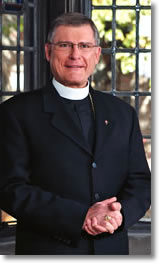by Rev. Jerry Kieschnick
 Despite its current economic or political clime, Bethlehem is still the place where Christ was born—where many still travel to remember a night long ago in this little town when the Light of the World came into its ‘dark streets.’
Despite its current economic or political clime, Bethlehem is still the place where Christ was born—where many still travel to remember a night long ago in this little town when the Light of the World came into its ‘dark streets.’
Having visited Bethlehem just two months ago, I have a new perspective on the words from the familiar Christmas carol, “O Little Town of Bethlehem.” The small town about which we sing, “how still we see thee lie,” today reflects the scars left by the action verbs that mark her history—“sacked,” “rebuilt,” “conquered,” “captured,” “fortified,” “expelled,” “demolished,” and “rebuilt.” (See related story, page 6.)
Life in Bethlehem today lies in sharp contrast to a place where the nights were marked with “deep and dreamless sleep. . . .” The “little town’s” 30,000 residents are vividly reminded that any serene days of the past will not return any time soon as a 24-foot concrete wall is erected to separate the people of this West Bank Palestinian community from their Israeli neighbors.
The current reality was strikingly visualized when our group visited the Bethlehem home of an architect who had drawn plans for new ministry buildings in the city. His home at one time was valued at $2.8 million, largely because it overlooked the olive groves that have belonged to his family for hundreds of years.
Standing on the porch of that home, one now can see only the 24-foot concrete wall less than half a stone’s throw away. The acres of olive groves are quite inaccessible. To check the centuries-old trees and to harvest their produce requires that the owners exit through one of three gates in that wall—no simple task—and travel many, many miles around that wall.
The gray starkness of that concrete wall only too accurately reflects the atmosphere hovering over present-day Bethlehem. With outside access becoming increasingly difficult, the tourism market, an economic staple for the region, continues to dwindle. Unemployment in the area tends toward 50 percent. Meanwhile, the Israeli “security barrier” that eventually will stretch about 550 miles continues to be built, marking yet other verbs in their history—“separated” and “isolated.”
Somehow, in the midst of these challenges, a sense of expectation remains in Bethlehem, echoing the words of the carol, “Yet, in thy dark streets shineth the everlasting light.” While the Christian leaders and people we visited there did not exude overt optimism for the future, they still were filled in a quiet way with hope.
Their hope was exhibited in service to others in a K-12 school, a college, a health and wellness center, and The International Center of Bethlehem, all sponsored originally by the pastor and people of Christmas Lutheran Church in Bethlehem, and all of which gain support from a U.S. group known as “Bright Stars of Bethlehem.” These acts of service reminded me of how so many respond in our own country during tough or troubled times.
Although Bethlehem today is far from the way we picture it on our Christmas cards, there still is something special about being on the streets made prominent in the carol. As one stands in Manger Square, one still gets the sense that “the hopes and fears of all the years are met in thee tonight.”
Regardless of one’s personal circumstances, challenges, setbacks, or anxieties, the fears of the day still seem to melt away in that place. Despite its current economic or political clime, Bethlehem is still the place where Christ was born—where many still travel to remember a night long ago in this little town when the Light of the World came into its “dark streets.”
Lasting peace in the Middle East may, or may not, be achieved in my lifetime. But I am thankful that one night in Bethlehem my fellow travelers and I had a taste of its transcendent meaning once again.
“O little town of Bethlehem, how still we see thee lie!
Above thy deep and dreamless sleep the silent stars go by.
Yet, in thy dark streets shineth the everlasting light.
The hopes and fears of all the years are met in thee tonight.”
e-mail: president@lcms.org
Web page: www.lcms.org/president




